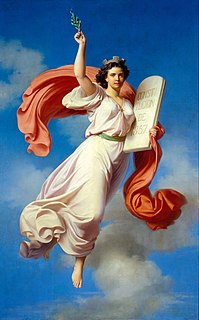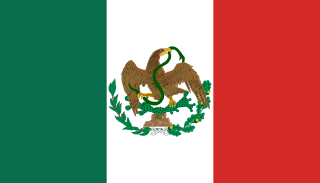Related Research Articles

Charro has several meanings, but it generally refers to Mexican horse riders, who maintain traditional dress, such as some form of sombrero, which in Mexican Spanish are called sombrero de charro. The charros could also be thought of as old Mexican cowboys who dress like such, although more modern dress is now seen on those who still work the ranches (rancheros). See also, vaquero.

The Mexican Empire was a constitutional monarchy, the first independent government of Mexico and the only former colony of the Spanish Empire to establish a monarchy after independence. It is one of the few modern era, independent monarchies that have existed in the Americas, along with the Brazilian Empire, and the First and Second Haitian Empires. It is typically denominated as the First Mexican Empire to distinguish it from the Second Mexican Empire.

La Reforma, refers to a pivotal set of laws, including a new constitution, that were passed in Mexico during the 1850s after the Plan of Ayutla overthrew the dictatorship of Santa Anna. They were intended as modernizing measures: social, political, and economic, aimed at undermining the traditional power of the Catholic Church and the army. The reforms sought the separate church and state, equality before the law, and economic development.

Jose Joaquin Palma was a Cuban writer who was the author of the Guatemalan national anthem's lyrics.

The Central University of Venezuela is a public university of Venezuela located in Caracas. It is widely held to be the highest ranking institution in the country, and it also ranks 18th in Latin America. Founded in 1721, it is the oldest university in Venezuela and one of the oldest in the Western Hemisphere.

The National Museum of Anthropology is a national museum of Mexico. It is the largest and most visited museum in Mexico. Located in the area between Paseo de la Reforma and Mahatma Gandhi Street within Chapultepec Park in Mexico City, the museum contains significant archaeological and anthropological artifacts from Mexico's pre-Columbian heritage, such as the Stone of the Sun and the Aztec Xochipilli statue.
Antonio Alatorre Vergara was a Mexican writer, philologist and translator, famous due to his influential academic essays about Spanish literature, and because of his book Los 1001 años de la lengua española.

José Antonio de Alzate y Ramírez was a priest in New Spain, scientist, historian, cartographer, and journalist.
Fondo de Cultura Económica is a Spanish language, non-profit publishing group, partly funded by the Mexican government. It is based in Mexico but it has subsidiaries throughout the Spanish-speaking world.

The National Museum of Natural Sciences is the national museum of natural history of Spain. It is situated in the center of Madrid, by the Paseo de la Castellana. It is managed by the Spanish National Research Council (CSIC).
Events in the year 1919 in Mexico.

Eduardo Zamacois y Zabala was a Spanish Academic painter who specialized in small-scale canvases. He was the father of the French writer, Miguel Zamacoïs, brother of the writer Niceto de Zamacois, the singer Elisa Zamacois and the actor Ricardo Zamacois, and also an uncle of the writer Eduardo Zamacois and the music composer Joaquín Zamacois.

Eduardo Zamacois y Quintana was a Cuban-Spanish novelist and journalist. A leading figure of the boom of short novel collections in Spain, and a representative of the bohemian literary scene in the country, he spent a substantial part of his life in Paris and, following the end of the Spanish Civil War, exiled in the Americas.

The Supreme Executive Power was the provisional government of Mexico that governed between the fall of the First Mexican Empire in April 1823 and the election of the first Mexican president, Guadalupe Victoria, in October 1824. After Emperor Iturbide abdicated, the sovereignty of the nation passed over to congress, which appointed a triumvirate, made up of Guadalupe Victoria, Pedro Celestino Negrete, and Nicolas Bravo, to serve as the executive, while a new constitution was being written.
Juan Niceto de Zamacois y Urrutia was a Spanish journalist, playwright, poet, novelist and historian resident in Mexico. He was half-brother of the painter Eduardo Zamacois y Zabala, the singer Elisa Zamacois, and the actor Ricardo Zamacois, and also was uncle of the writers Miguel Zamacoïs and Eduardo Zamacois, and the music composer Joaquín Zamacois.
Sister Josefa de los Dolores Peña y Lillo Barbosa, OP was a Dominican nun and a self-taught writer of the Chilean Colonial period ascribed to Catholic confessional discourse produced by Indian nuns in South American cloisters during the fifteenth and seventeenth centuries. She cultivated the epistolary genre, but also rarely wrote poetry.
María Luisa Mendoza, also known as La China Mendoza, was a Mexican journalist, novelist and politician. She served as a federal delegate from the state of Guanajuato to the 53rd Mexican legislature.

Elisa Pedra Zamacois y Zabala was a Spanish singer and actress. She was half-sister of the writer Niceto de Zamacois, and sister of the painter Eduardo Zamacois y Zabala, and the actor Ricardo Zamacois, and also was aunt of the writers Miguel Zamacoïs and Eduardo Zamacois, and the music composer Joaquín Zamacois.
Ezequiel González Mas was a Spanish historian of Spanish literature, a cervantista, poet, art critic and writer.
References
- ↑ Hellion, Denise. "Documentos fundacionales del Museo Público de Historia Natural,Arqueología e Historia". Gaceta de Museos (in Spanish). INAH.
- ↑ Zamacois, Niceto (1882). Historia de Mexico: Tomo XVIII (in Spanish). J.F. Parres. p. 6.
- ↑ Zamacois, Niceto (1882). Historia de Mexico: Tomo XVIII (in Spanish). J.F. Parres. p. 6.
- ↑ Zamacois, Niceto (1882). Historia de Mexico: Tomo XVIII (in Spanish). J.F. Parres. p. 6.
- ↑ Zamacois, Niceto (1882). Historia de Mexico: Tomo XVIII (in Spanish). J.F. Parres. p. 6.
- ↑ Zamacois, Niceto (1882). Historia de Mexico: Tomo XVIII (in Spanish). J.F. Parres. p. 7.
- ↑ Zamacois, Niceto (1882). Historia de Mexico: Tomo XVIII (in Spanish). J.F. Parres. pp. 12–13.
- ↑ Ojeda, Alicia (20 March 2019). "La Academia Imperial de Ciencias y Literatura". Encyclopedia de Literatura en Mexico.